Natural preservatives can transform your signature fragrance into an eco-friendly masterpiece. You'll find effective options like sodium benzoate and essential oils that combat microorganisms while being gentle on your skin and the environment. By combining ingredients like phenethyl alcohol with glyceryl caprylate, you'll achieve ideal preservation without synthetic chemicals. Proper storage in cool, dark places enhances longevity. Discover how these green alternatives can revolutionize your perfume experience.
Understanding Natural Preservative Systems in Perfumery
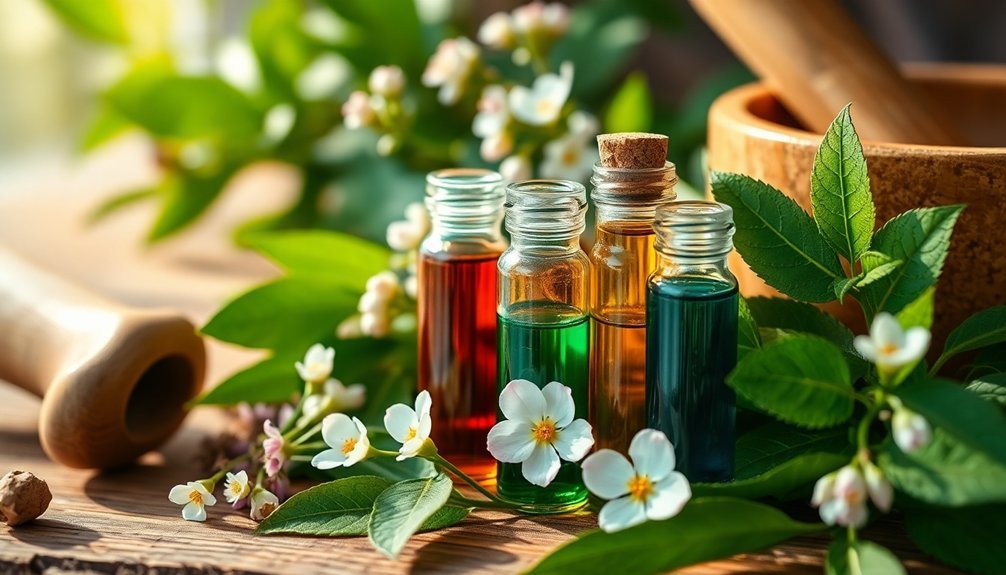
While traditional perfumes often rely on synthetic preservatives, natural preservative systems offer a more sustainable approach to fragrance preservation.
You'll find effective options like sodium benzoate and sorbic acid, which are extracted from plants and fruits, working alongside potassium sorbate to protect against molds and yeasts.
To achieve the best results, you'll need to take pH levels carefully into account – many natural preservatives work best in formulations with a pH of 5.4 or below. Products without proper preservation can develop foul odors and become unsafe for use.
You can create a robust preservation system by combining different natural ingredients, such as gluconolactone with sodium benzoate.
These combinations don't just protect your fragrance; they're also gentler on your skin and the environment.
When selecting preservatives, remember that they may affect your product's viscosity and color, so choose ones that complement your fragrance's desired characteristics.
Essential Oils With Natural Preservation Properties
Among nature's most effective preservatives, you'll find citrus essential oils containing limonene, which actively fights both bacteria and fungi in your fragrances.
Tea tree oil's main component, terpinen-4-ol, offers broad-spectrum antimicrobial protection while adding a fresh, medicinal note to your natural perfume formulations. Modern encapsulation technology helps stabilize these volatile oils for longer-lasting preservation benefits.
These powerful botanical preservatives work together synergistically, allowing you to create safer, more sustainable fragrances without synthetic preservatives.
Citrus Family Protection Properties
As the food and fragrance industries seek sustainable alternatives to synthetic preservatives, citrus essential oils have emerged as powerful natural preservatives derived from fruit peels.
You'll find these oils are primarily extracted through cold-pressing oranges, lemons, and bergamot, turning what would be waste into valuable ingredients.
The secret to their preservation power lies in limonene, a compound that effectively fights bacteria and fungi. Their effectiveness rivals that of thyme and oregano for bacterial control in many applications.
When you're creating fragrances, these oils don't just protect—they also add delightful citrus notes. You can incorporate them through various methods, including nanoemulsion coatings and direct blending.
What makes citrus oils particularly appealing is their eco-friendly nature and versatility.
They're rich in antioxidants, thanks to flavonoids and carotenoids, making them an excellent choice for natural fragrance preservation.
Tea Tree Benefits Explained
Tea tree oil stands as a powerhouse among natural preservatives, offering remarkable antimicrobial and antifungal properties derived from the Australian Melaleuca plant.
You'll find this essential oil particularly effective in extending your fragrance's shelf life while fighting harmful microbes and fungi.
The oil's potency comes from its rich composition of monoterpenols, especially terpinen-4-ol, which makes up about 45% of its structure.
When you add tea tree oil to your fragrance formulations, you're not just getting preservation benefits – you're also incorporating a natural deodorizer that eliminates bacterial growth and unwanted odors.
What makes tea tree oil even more appealing is its cost-effectiveness.
It takes 100 kg of leaves to produce 1-2 liters of oil, yet it remains affordable and delivers multiple benefits beyond preservation.
Plant-Based Antioxidants for Fragrance Longevity
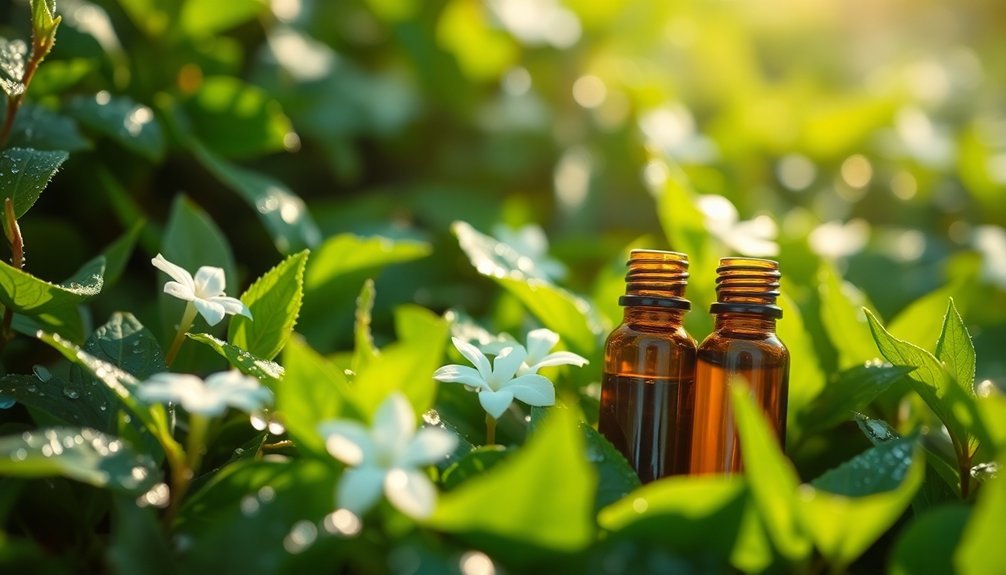
Natural antioxidants found in essential oils serve as powerful preservatives for fragrance longevity while delivering remarkable skin benefits.
When you choose fragrances containing cinnamon, ylang ylang, or sandalwood, you're getting potent compounds like cinnamaldehyde, eugenol, and linalool that fight free radicals and prevent oxidative stress.
These plant-based antioxidants don't just preserve your fragrance – they're actively protecting your skin.
Components like limonene in neroli and boswellic acids work to reduce inflammation, combat signs of aging, and shield your skin from environmental damage.
You'll find these natural preservatives in eco-conscious fragrances that prioritize sustainable sourcing and cruelty-free production.
Sustainable Extraction Methods for Green Preservatives
While conventional extraction methods often rely heavily on harmful solvents, modern sustainable techniques have revolutionized how we obtain green preservatives from botanical sources.
You'll find that methods like supercritical fluid extraction and microwave-assisted extraction dramatically reduce both energy consumption and solvent usage while maintaining high-quality results.
These green extraction techniques follow the e3 principle, ensuring you're getting preservatives that are both effective and environmentally responsible.
By using ultrasound-assisted extraction and subcritical water extraction, you're supporting processes that operate at lower temperatures and pressures, minimizing environmental impact.
Plus, these methods enhance the extraction of natural antioxidants and preservative compounds from organic plant materials while supporting sustainable farming practices.
The result? You're protecting your fragrance while protecting the planet.
Combining Natural Preservatives for Maximum Effectiveness
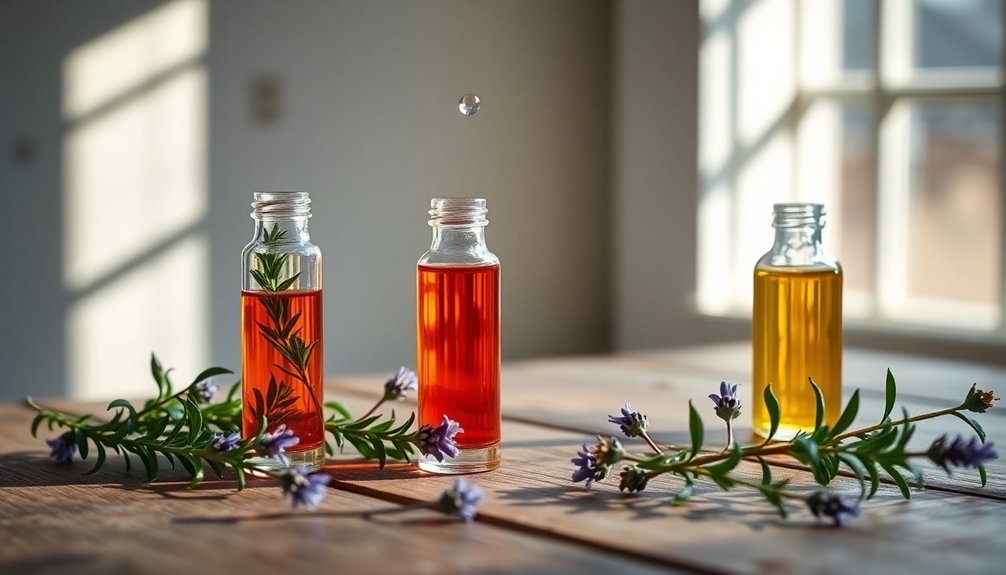
Combining multiple natural preservatives creates a powerful synergistic effect that enhances their protective capabilities beyond what each ingredient could achieve alone.
You'll find that pairing phenethyl alcohol with glyceryl caprylate not only boosts antimicrobial protection but also adds moisturizing benefits.
When you're formulating, consider adding p-anisic acid as a co-preservative to mask unwanted scents while complementing other natural preservatives.
Essential oils like lavender and rose work exceptionally well with plant extracts to combat microorganisms.
While you'll need to test for compatibility and skin sensitivity, these natural combinations can help you achieve broad-spectrum protection across various pH levels.
Remember that you might need higher concentrations than synthetic alternatives, but you'll gain the advantage of meeting consumer demand for natural products while maintaining effective preservation.
Shelf Life Enhancement Through Botanical Solutions
Natural antioxidant extracts like rosemary seed and grapefruit seed can strengthen your perfume's resistance to oxidation while maintaining its eco-friendly status.
You'll find these botanical solutions particularly effective when combined with proper storage techniques, such as using violet-glass bottles and keeping fragrances in cool, dark spaces.
To prevent microbial growth in your natural perfumes, you can incorporate plant-based preservatives while monitoring regularly for any changes in color, scent, or texture.
Natural Antioxidant Extracts
As consumers increasingly demand clean-label products, botanical antioxidant extracts have emerged as powerful shelf-life enhancers in fragrance preservation. You'll find rosemary extract leading the way with its potent phenolic diterpenes, while citrus flavonoids offer exceptional protection against oxidation.
| Natural Extract | Key Benefits |
|---|---|
| Rosemary CO2 | Extends carrier oil life at 0.2-0.4% |
| Citrus Flavonoids | Prevents bacterial growth |
| Phenolic Compounds | Neutralizes free radicals |
| Synergistic Blends | Enhances preservation power |
| Plant-Based Solutions | Appeals to eco-conscious buyers |
When formulating your signature fragrance, you'll want to incorporate these natural preservatives strategically. Remember that rosemary antioxidant CO2 isn't suitable as a standalone preservative for water-based formulas, and you'll need stability testing to guarantee peak performance.
Microbial Growth Prevention Methods
While traditional preservatives rely on synthetic compounds, botanical solutions offer effective microbial control through diverse natural agents.
You'll find powerful antimicrobial properties in herbs like garlic, cinnamon, and turmeric, which can protect your fragrance from harmful microorganisms. Essential oils from thyme, oregano, and clove provide additional protection when used in controlled amounts.
For thorough preservation, you can implement hurdle technology, combining multiple botanical barriers instead of relying on a single preservative.
This approach works well with natural fixatives like orris root powder and benzoin resin, which help retain your fragrance's scent. You can also incorporate natural chemicals such as organic acids and alcohol to further enhance protection against microbial growth, ensuring your signature scent stays fresh and safe.
Environmental Impact of Natural Preservation Methods
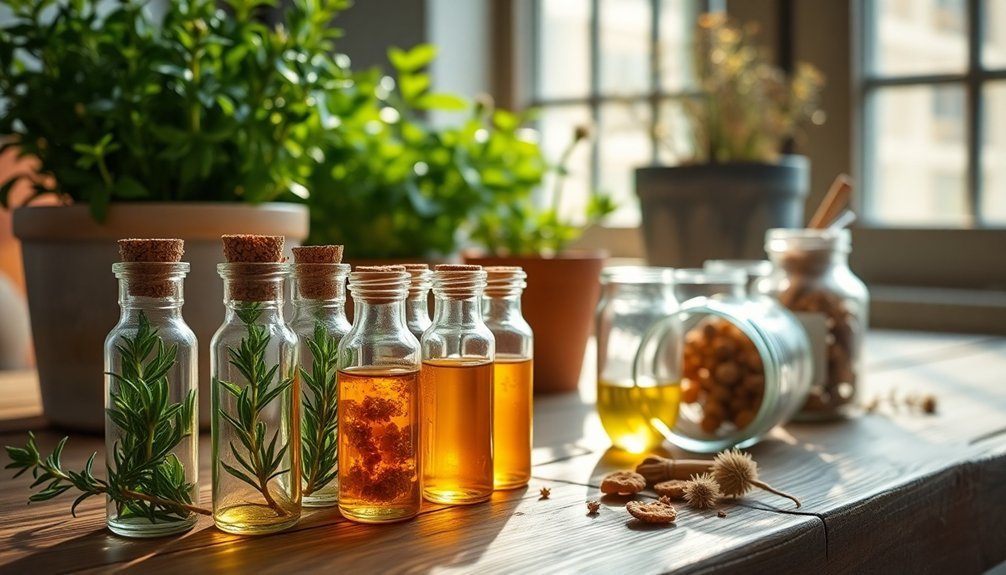
Modern preservation methods in natural fragrances demonstrate remarkable environmental benefits through their minimal ecological footprint.
You'll find that these methods, like steam distillation and enfleurage, don't rely on harsh chemicals, greatly reducing VOC emissions and water pollution. When you choose naturally preserved fragrances, you're supporting sustainable harvesting practices that protect endangered plant species and maintain biodiversity.
The environmental advantages extend beyond production. Natural preservatives break down harmlessly in the environment, unlike synthetic alternatives that can accumulate in human tissues and ecosystems.
You're also contributing to waste reduction, as many natural fragrance brands now use biodegradable or refillable packaging. By selecting these eco-conscious preservation methods, you're helping protect air quality, water resources, and soil health while supporting sustainable agricultural practices.
Ethical Sourcing of Green Preservative Materials
Building on the environmental benefits of natural preservation methods, ethical sourcing guarantees these green materials maintain high sustainability standards throughout the supply chain.
When sourcing green preservatives, you'll need to evaluate suppliers using thorough life cycle assessments and verify their sustainability certifications like ISO 14001, Fair Trade, or B Corp status.
Look for suppliers who openly share their ingredient origins and production methods while demonstrating strong ESG performance.
You'll want to prioritize local sources to reduce transportation emissions and support regional economies.
Choose partners who meet specific criteria for carbon footprint reduction, waste management, and ethical labor practices.
Storage and Stability of Naturally Preserved Fragrances
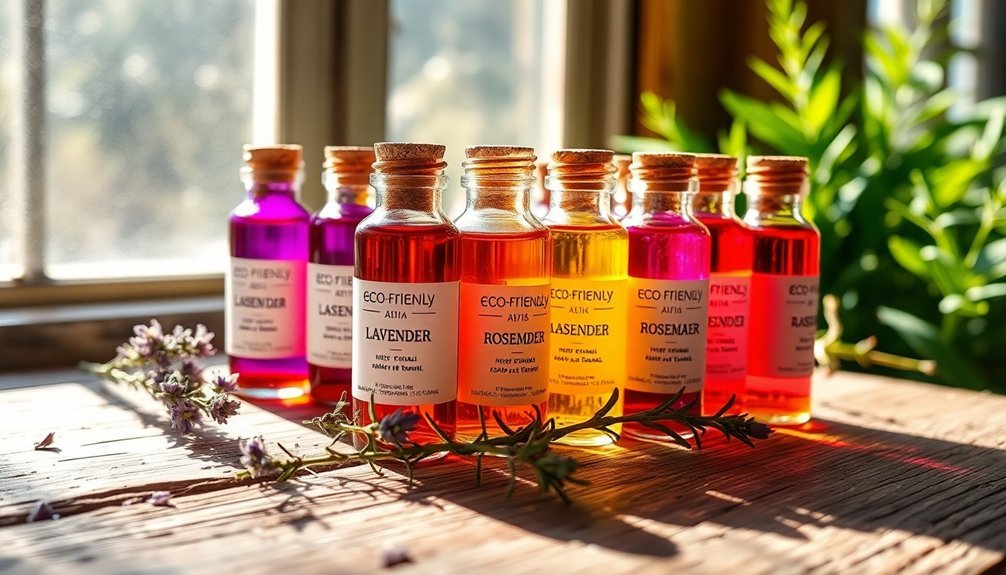
Proper storage techniques play an essential role in maintaining the integrity of naturally preserved fragrances.
You'll want to keep your perfumes in a cool, dark place away from direct sunlight and heat sources, as these elements can trigger oxidation and alter the fragrance's chemical composition.
Don't store your fragrances in the bathroom, where humidity and temperature fluctuations can accelerate deterioration. Instead, choose a closet, drawer, or cabinet that maintains consistent temperatures.
After each use, make certain you've tightly sealed the cap and stored the bottle upright to prevent leakage. Keep your perfumes in their original packaging for added protection against environmental factors.
For longer-lasting results, you can refrigerate your fragrances, but make certain the temperature remains stable.
When traveling, opt for smaller vessels to minimize air exposure and prevent damage.
Safety Guidelines for Natural Perfume Preservation
Beyond storage methods, understanding safety guidelines for natural perfume preservation helps protect both your fragrances and your well-being.
Keep your perfumes away from heat sources, including radiators and windowsills, as high temperatures will dilute the molecules.
You'll want to shield your fragrances from direct light by storing them in their original packaging or opaque containers to prevent degradation of aromatic compounds.
Don't leave your perfume bottles uncapped for extended periods, as humidity and air exposure can trigger unwanted chemical reactions.
When handling your fragrances, avoid vigorous shaking that introduces air bubbles. Instead, gently roll the bottle between your palms.
Stick to the original bottles rather than transferring your perfumes to different containers, as repackaging can compromise the scent's integrity through increased exposure.
Frequently Asked Questions
Can Natural Preservatives Affect the Scent Profile of My Signature Fragrance?
Yes, natural preservatives can affect your fragrance's scent profile. They'll interact with fragrance molecules, potentially altering top, middle, and base notes. Some preservatives may add subtle aromas or enhance note longevity.
How Do Temperature Fluctuations Impact Eco-Friendly Preservative Performance?
Temperature fluctuations can reduce your preservative's effectiveness, as heat speeds up degradation while cold slows down activation. You'll need to store products between 15-25°C to maintain stability and prevent microbial growth.
Are Natural Preservatives More Expensive Than Synthetic Alternatives?
Yes, you'll find natural preservatives are typically more expensive than synthetic ones. They require costlier raw materials, complex production processes, and rigorous quality control. Higher sourcing and manufacturing expenses drive up their final price.
Can I Mix Different Brands of Natural Preservatives Together?
You shouldn't mix different brands of natural preservatives together. It's unsafe and can create unpredictable reactions, reduce effectiveness, or form harmful compounds. Stick to using a single, well-tested preservative system instead.
Do Eco-Friendly Preservatives Require Special Packaging Materials?
Yes, you'll need eco-friendly packaging that's compatible with natural preservatives. Consider using PaperFoam®, biodegradable plastics with EcoPure® additives, or glass containers to maintain preservative stability and environmental responsibility.
In Summary
By choosing eco-friendly preservatives for your signature fragrance, you're not just protecting your scent – you're protecting our planet. Whether you're using essential oils, plant-based antioxidants, or sustainable extraction methods, you'll find that natural preservation can be just as effective as synthetic options. Remember to follow safety guidelines, store your fragrances properly, and source your materials ethically to create a truly sustainable signature scent.

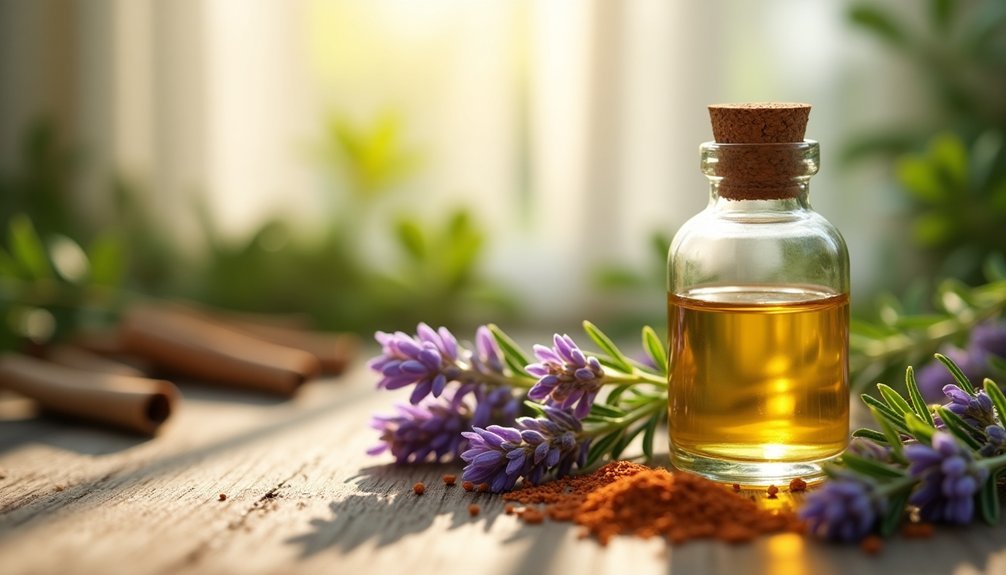
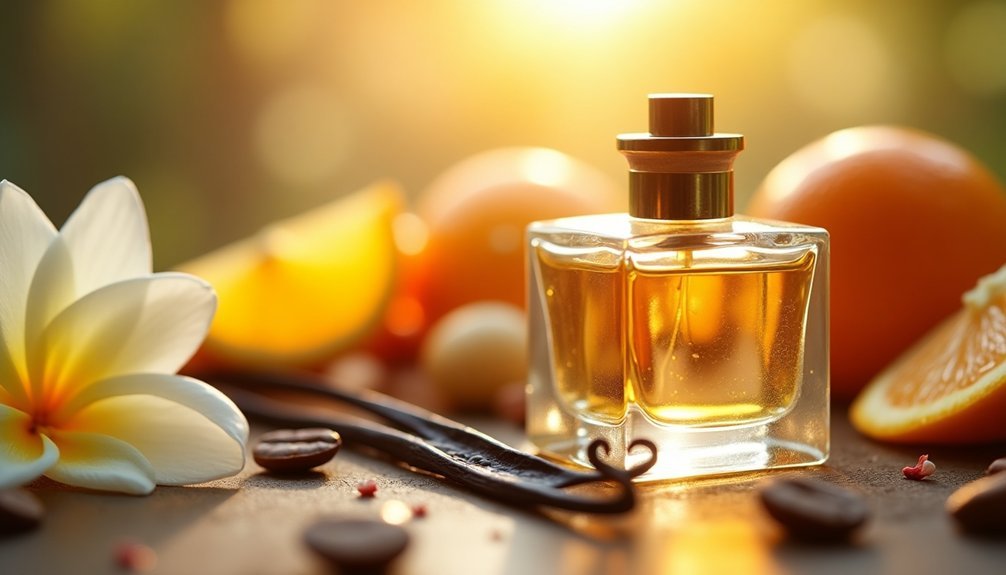

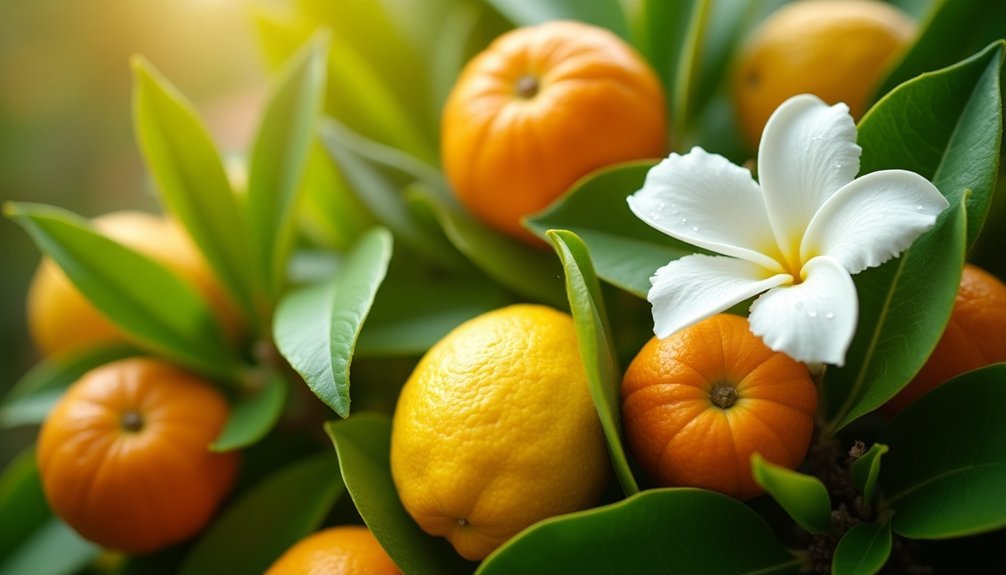
Leave a Reply